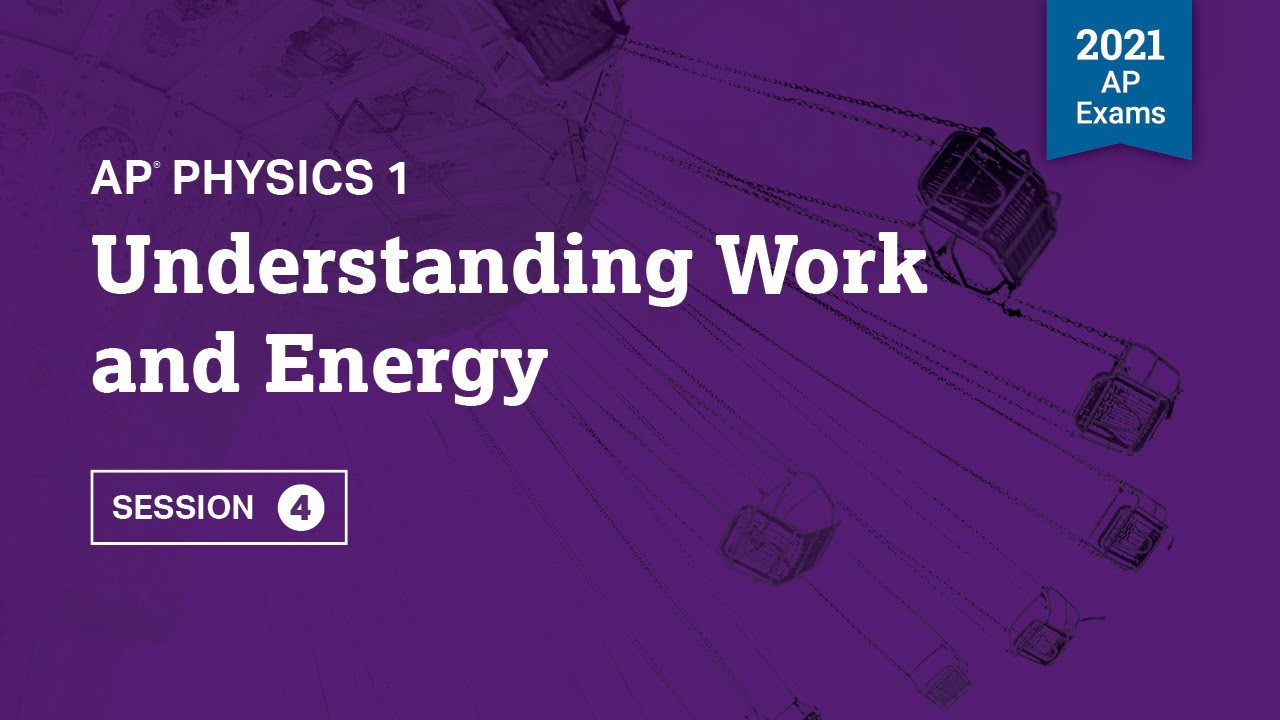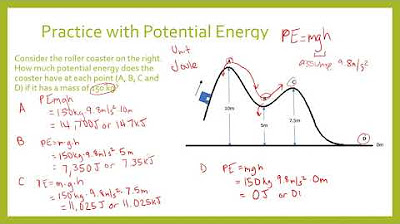LOL diagrams | Work and energy | Physics | Khan Academy
TLDRThe transcript introduces LOL diagrams as a visualization tool for understanding the conservation of energy. It explains that an energy system includes objects whose energies are tracked, and these systems are represented in a chart format. The video uses examples, such as a falling mass and a mass-spring system, to illustrate how to apply LOL diagrams to analyze energy transformations while emphasizing that internal work within a system does not change its total energy. The concept is further clarified by contrasting scenarios with and without external work, highlighting the importance of system boundaries in energy conservation calculations.
Takeaways
- 📊 LOL diagrams are a visual tool for understanding the conservation of energy, representing an energy system with a chart that looks like an 'L' followed by an 'O', and then another 'L'.
- 🌐 An energy system can be an object or a collection of objects whose energies are being tracked, and it can include the Earth if specified by the problem's context.
- 📈 The initial energy in a system can be potential energy, kinetic energy, or elastic (spring) energy, depending on the scenario.
- 🔄 Energy conservation means that the total initial energy plus any external work done equals the total final energy within the system.
- 🚫 If the Earth is considered part of the system, the work it does on an object (e.g., a falling mass) is internal and does not change the total energy of the system.
- ⚖️ The value in LOL diagrams lies in conceptualizing energy transformations, not in the precise numerical values, which can vary but must remain consistent within the diagram.
- 🔄 In the absence of external work, the sum of initial and internal work should equal the final energy to satisfy energy conservation.
- 🔄 When external work is involved, such as friction, it can either add to or subtract from the system's energy, affecting the conservation equation.
- 📝 LOL diagrams can be directly translated into a conservation of energy equation, allowing for the calculation of various physical quantities like height or speed.
- 🌟 The choice of whether surfaces or other elements are part of the system affects how energy transformations are represented and calculated.
- 💡 Understanding LOL diagrams helps clarify the concept of energy conservation and the role of internal and external work in energy transformations within a defined system.
Q & A
What are LOL diagrams?
-LOL diagrams, which stand for Level Of Lift diagrams, are a visual tool used to understand the conservation of energy. They help to define an energy system and track the energies within it, typically represented in a bar chart format that resembles the letters 'L', 'O', and 'L'.
How do you define an energy system?
-An energy system is defined as an object or a collection of objects whose energies are being tracked. It includes everything that is part of the analysis, such as a mass, a spring, and even the Earth in some cases, depending on the context of the problem.
What is the significance of including the Earth in an energy system?
-Including the Earth in an energy system is significant because it can be a part of the gravitational potential energy calculation. When the Earth is considered part of the system, the work done by the Earth's gravitational force on the mass is considered internal work, which does not change the total energy of the system according to the conservation of energy principle.
How does the conservation of energy principle apply to LOL diagrams?
-The conservation of energy principle states that the total initial energy of the system, plus any external work done on the system, must equal the total final energy of the system. This principle is used in LOL diagrams to ensure that the energy values at the beginning and end of a process are consistent, reflecting the conservation of energy.
What happens when the Earth is not included in the energy system?
-When the Earth is not included in the energy system, the work done by the Earth's gravitational force is considered external work. This means that the system's energy can change because energy is being transferred into or out of the system due to external forces or interactions.
How can you represent external work in a LOL diagram?
-In a LOL diagram, external work is represented as a positive or negative value that adjusts the total energy of the system. If external work is done on the system, it adds to the total energy, while if the system does work externally (like overcoming friction), it results in a loss of energy from the system.
What is the role of friction in the conservation of energy?
-Friction is a dissipative force that can do external work on a system, leading to a loss of mechanical energy which is converted into thermal energy. If friction is included in the system, it is accounted for as negative work, and if it is external, it is represented as an external force taking energy away from the system.
How can you translate a LOL diagram into a conservation of energy equation?
-A LOL diagram can be directly translated into a conservation of energy equation by using the initial and final energy values represented in the diagram. The initial energy plus any external work done must equal the final energy, which can be expressed mathematically using formulas for potential energy (mgh), kinetic energy (1/2 mv^2), and spring energy (1/2 kx^2).
What is the importance of choosing the correct system boundaries?
-Choosing the correct system boundaries is crucial for accurately applying the conservation of energy principle. The boundaries determine which objects and interactions are included in the energy calculations. Incorrectly defining the system can lead to errors in the analysis of energy conservation or transfer.
What is the conceptual value of LOL diagrams in learning physics?
-LOL diagrams provide a visual and intuitive way to understand complex energy relationships and transformations. They help students to conceptualize the conservation of energy, making it easier to grasp the principles behind energy conservation and to solve problems involving energy transfers and transformations.
Can LOL diagrams be used for systems involving non-conservative forces?
-Yes, LOL diagrams can be used for systems involving non-conservative forces, but they must account for the work done by these forces as external work. This external work can result in a change in the system's total mechanical energy, which is reflected in the diagram as a loss or gain of energy due to non-conservative forces like friction.
Outlines
📊 Introduction to LOL Diagrams
This paragraph introduces LOL diagrams as a visualization tool for understanding the conservation of energy. It explains that an energy system consists of objects whose energies are being tracked. The instructor clarifies that the term 'LOL' does not stand for 'laugh out loud' but refers to the shape of the energy chart, resembling an 'L' followed by an 'O' and another 'L'. The paragraph delves into the concept of energy systems and how to select what is part of the system. It uses the example of a mass released from rest at a height to illustrate how to track the transformation of gravitational potential energy into kinetic energy, emphasizing the importance of consistency in the representation of energies within the LOL diagram framework.
🔄 Conservation of Energy in Internal Work
This paragraph discusses the concept of internal work within an energy system and how it relates to the conservation of energy. The instructor explains that when work is done internally between objects in the system, the total energy remains unchanged. The use of LOL diagrams is highlighted as a direct translation into a conservation of energy equation, where initial energy plus external work equals final energy. An example is provided to contrast the scenario with and without external work, using the same mass and earth system to demonstrate how the earth's role as part of or outside the system affects energy conservation. The analogy of money exchange between two people is used to clarify the concept of internal work not altering the total energy within a system.
🌐 External Work and Energy Conservation
The paragraph explores the impact of external work on the conservation of energy. It uses the example of a mass-spring system to illustrate how the inclusion or exclusion of the earth in the energy system affects the calculation of energy conservation. The initial condition of the mass-spring system is described, with the spring's stored energy and the mass's lack of gravitational potential energy at the starting point. The transformation of spring energy into kinetic energy and gravitational potential energy is detailed, emphasizing the conservation of energy in the absence of external work. The paragraph then discusses how the introduction of friction as an external force affects the system by either reducing the final kinetic energy or generating thermal energy within the system, depending on whether the surfaces are considered part of the system or not.
Mindmap
Keywords
💡LOL diagrams
💡Energy System
💡Conservation of Energy
💡Gravitational Potential Energy
💡Kinetic Energy
💡Spring Energy
💡Internal Work
💡External Work
💡Thermal Energy
💡Energy Transformation
💡Friction
Highlights
LOL diagrams are introduced as a visualization tool for the conservation of energy principle.
An energy system is defined as an object or collection of objects whose energies are being tracked.
LOL diagrams consist of two charts: one defining the system and another charting the energies.
The concept of gravitational potential energy and its relation to the mass and the Earth is discussed.
The transformation of potential energy into kinetic energy is illustrated using a falling mass example.
The importance of consistency in representing energy changes in LOL diagrams is emphasized.
The example of a mass falling from rest demonstrates how internal work within a system does not change its total energy.
An analogy of money exchange between two people is used to explain the conservation of energy within a system.
LOL diagrams can be directly translated into a conservation of energy equation.
The impact of considering the Earth as part of or outside the energy system on energy calculations is discussed.
A scenario where energy is not conserved due to external work is presented, changing the perspective on the Earth's role.
The example of a mass compressed against a spring and its subsequent motion is used to illustrate energy conservation.
The role of friction and other dissipative forces in altering the energy of a system is explored.
The concept of thermal energy generated due to friction is introduced within the context of energy conservation.
The two approaches to handling friction in energy system calculations are explained: including surfaces as part of the system or as external.
LOL diagrams are highlighted as an effective method for visualizing the conservation of energy principle.
The total initial energy plus any external work must equal the total final energy in a system, as per the conservation law.
Transcripts
Browse More Related Video

2021 Live Review 4 | AP Physics 1 | Understanding Work and Energy

Internal Energy

More on internal energy | Thermodynamics | Physics | Khan Academy

8.01x - Lect 11 - Work, Kinetic & Potential Energy, Gravitation, Conservative Forces

AP Physics Workbook 4.C Energy Graphs

Potential and Kinetic Energy with Practice Problems
5.0 / 5 (0 votes)
Thanks for rating: